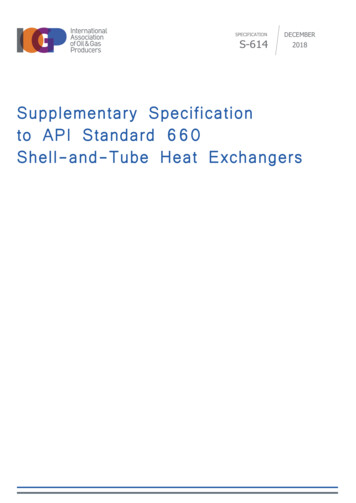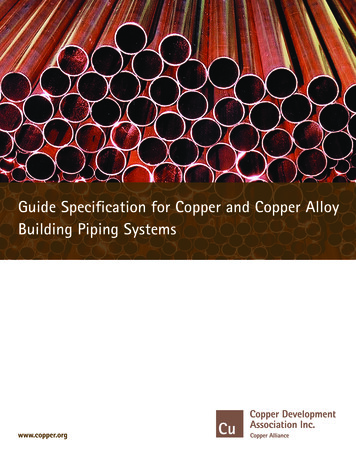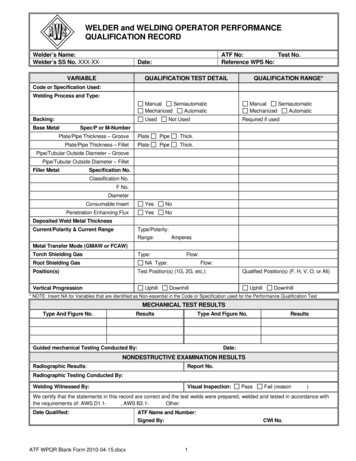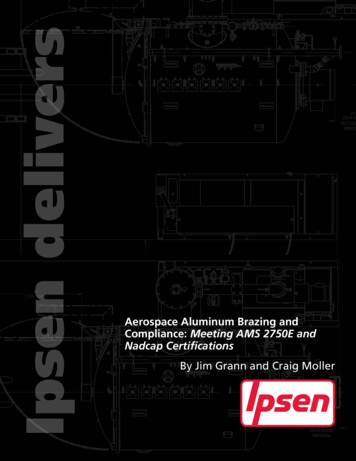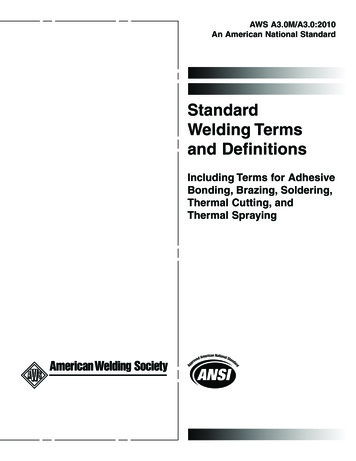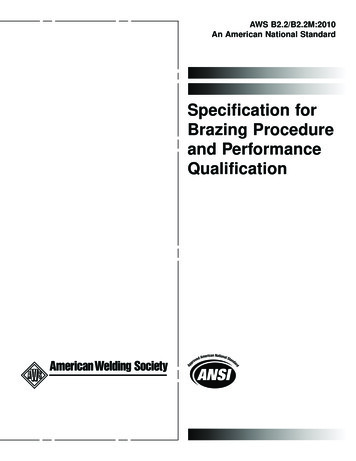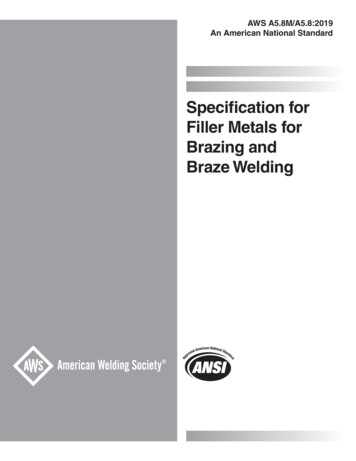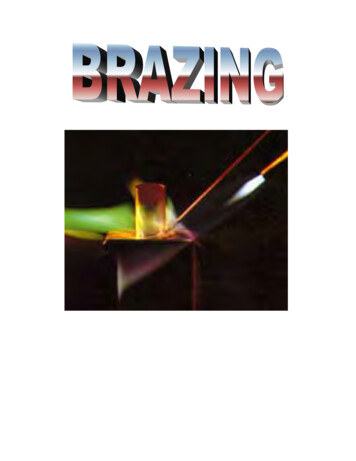
Transcription
The Brazing BookThis book contains a significant amount of information on the process of brazing.It was created by Handy & Harman to assist both the novice brazier and theseasoned engineer. For years, this publication has been well received and a veryuseful tool. This publication has been updated to incorporate the many changesthat have occurred within the industry. However, the purpose of this bookremains the same: to expand the applications of brazing by relaying the manyadvantages of it as a metal-joining method -- while being quite candid about itslimitations. And we highlight the many people and industries that are now usingbrazing wherever possible to increase their manufacturing efficiencies.For ease of understanding, we've divided the book into five main sections.Section one, "The Idea of Brazing," explains exactly what brazing is, where to useit, and how to perform it properly. Section Two, "Brazing in Action," presentsdetailed photographic case histories illustrating some of the many applications inwhich brazing is used today. Section Three, "Choices in Brazing Materials," listsand describes the many brazing products available from Handy & Harman andfeatures useful selection charts to help you choose the best filler metals andfluxes for your particular brazing application. For your convenience, we've alsoincluded a number of technical reference tables and related information. SectionFour, "Available Reference Materials," lists a variety of other brazing relatedinformation available to further assist you in your brazing operations. We knowyou'll find The Brazing Book informative and helpful. We hope you'll find itinteresting as well.2
What is brazing?Brazing is the joining of metals through the use of heat and a filler metal – one whose meltingtemperature is above 840 F (450 C) but below the melting point of the metals being joined. (Amore exact name for the brazing process discussed in this book may be "silver brazing," since inmost cases the filler metal used is a silver alloy. To remain brief, we'll use the term "brazing"throughout this book, with the understanding that we are referring to a torch brazing process witha silver-bearing filler metal. Where exceptions occur, it will be noted.) Brazing is probably themost versatile method of metal joining today, for a number of reasons. Brazed joints are strong.On non- ferrous metals and steels, the tensile strength of a properly made joint will often exceedthat of the metals joined. On stainless steels, it is possible to develop a joint whose tensilestrength is 130,000 pounds per square inch. (896.3 megapascals [MPa]). Brazed joints areductile, able to withstand considerable shock and vibration. Brazed joints are usually easy andrapidly made, with operator skill readily acquired. Brazing is ideally suited to the joining ofdissimilar metals. You can easily join assemblies that combine ferrous with nonferrous metals,and metals with widely varying melting points. Brazing is essentially a one-operation process.There is seldom any need for grinding, filing or mechanical finishing after the joint is completed.Brazing is performed at relatively low temperatures, reducing the possibility of warping,overheating or melting the metals being joined. Brazing is economical. The cost- per-jointcompares quite favorably with joints made by other metal joining methods. Brazing is highlyadaptable to automated methods. The flexibility of the brazing process enables you to matchyour production techniques very closely to your production requirements. With all itsadvantages, brazing is still only one of the ways in which you can join metals. To use brazingproperly, you must understand its relationship to other metal jointing methods. What are some ofthose methods and which should you use where?The versatility of brazing. Strong jointsDuctile jointsEase of operationSuited to dissimilar metalsOne-operation processRequires low temperaturesEconomicalHighly adaptable to automation3
The many ways to join metals.Brazing, as we've noted, relies on heat and a filler metal to join metals. There is nothing uniqueabout this. Welding and soldering are similar in these respects. And metals can also be joinedefficiently and economically without the need for heat or a filler metal at all, by mechanicalfastening or adhesive bonding. When would you use brazing, rather than one of these othermethods? It depends on the circumstances. Let’s start our evaluation of brazing as a metal joiningmethod by eliminating those situations were brazing is generally unsuitable. The first of these situations is the nonpermanent joint. This is the joint that’s made with future disassembly in mind. (For example, a pump connected to apiping assembly.)The pipes won't wear out, but some day the pump will. It's easier to disassemble a threaded orbolted pump connection than a brazed con- nekton. (You can "de-braze" a brazed joint if youhave to, but why plan on it?) For the typical non-permanent joint, mechanical fastening is usuallythe most practical method. There's another kind of joint where brazing will likely be your last,rather than your first, consideration. And that is the permanent, but low-strength joint. If you'rejoining metal assemblies that won't be subjected too much stress or strain, there are frequentlymore economical ways to join them than by brazing. (Mechanical fastening, for example, or softsoldering or adhesive bonding.) If you are selecting a method to seal the seams of tin cans, thereis nothing to stop you from brazing. Yet soft-soldering would be perfectly adequate for this lowstress type of bond. And soft-soldering is generally less expensive than brazing. In these twoareas – the non- permanent joint and the permanent but low-strength joint – other joiningmethods are adequate for the job and usually more economical than bronzing.Where does brazing fit in?Consider brazing hen you want permanent and strong metal-to-metal joints. Mechanicallyfastened joints (threaded, staked, riveted, etc.) generally don’t compare to brazed joints instrength, resistance to shock and vibration, or leak-tightness. Adhesive bonding and solderingwill give you permanent bonds, but generally neither can offer the strength of a brazed joint –strength equal to or greater than that of the base metals themselves. Nor can they, as a rule,produce joints that offer resistance to temperatures above 200 F (93 C). If you want metal jointsthat are both permanent and strong, it's best to narrow down your consideration to welding andbrazing. Welding and brazing both use heat. They both use filler metals. They can both beperformed on a production basis. But the resemblance ends there. They work differently, and youneed to understand the nature of that difference to know which method to use where.4
How welding works.Welding joins metals by melting and fusing them together, usually with the addition of a weldingfiller metal. The joints produced are strong, usually as strong as the metals joined or evenstronger. In order to fuse the metals, a concentrated heat is applied directly to the joint area. Thisheat is high temperature. It must be – in order to melt the "base" metals (the metals being joined)and the filler metals as well. So welding temperatures start at the melting point of the basemetals. Because welding heat is intense, it is impractical to apply it uniformly over a broad area.Welding heat is typically localized, pinpointed heat. This has its advantages. For example, if youwant to join two small strips of metal at a single point, an electrical resistance welding setup isvery practical.This is a fast, economical way to make strong, permanent joints by the hundreds and thousands.However, if the joint is linear, rather than pinpointed, problems arise. The localized heat ofwelding tends to become a disadvantage. For example, suppose you want to butt- weld twopieces of metal – start by beveling the edges of the metal pieces to allow room for the weldingfiller metal. Then weld, first heating one end of the joint area to melting temperature, then slowlytraveling the heat along the joint line, depositing filler metal in synchronization with the heat.This is a typical conventional welding operation. Let's look at its characteristics.5
It offers one big plus – strength. Properly made, the welded joint is at least as strong as themetals joined. But there ore minuses to consider. The joints made at high temperatures, highenough to melt both base metals and filler metal. High temperatures can cause problems, such aspossible distortion and warping of the base metals or stresses around the weld area. Thesedangers are minimal when the metals being joined are thick. But they may become problemswhen the base metals are thin sections. High temperatures are expensive as well since heat isenergy, and energy costs money. The more heat you need to make the joint, the more the jointwill cost to produce. Now consider the automated process. What happens when you join not oneassembly, but hundreds or thousands of assemblies? Welding, by its nature, presents problems inautomation. We know that a resistance weld joint made at a single point is relatively easy toautomate. But once the point becomes a line – a linear joint – the line has to be traced. It'spossible to automate this tracing operation, moving the joint line, for example, past a heatingstation and feeding filler wire automatically from big spools. But this is a complex and exactingsetup, warranted only when you have large production runs of identical parts. Of course, weldingtechniques continually improve. You can weld on a production basis by electron beam, capacitordischarge, friction and other methods. But these sophisticated processes usually call forspecialized and expensive equipment and complex, time consuming setups. They're seldompractical for shorter production runs, changes in assembly configuration or – in short – typicalday-to- day metal joining requirements.6
How brazing works.A brazed joint is made in a completely different way from a welded joint. The first big differenceis n temperature. Brazing doesn't melt the base metals. So brazing temperatures are invariablylower than the melting points of the base metals. And, of course, always significantly lower thanwelding temperatures for the same base metals. If brazing doesn't fuse the base metals, how doesit join them? It joins them by creating a metallurgical bond between the filler metal and thesurfaces of the two metals being joined.The principle by which the filler metal is drawn through the joint to create this bond is capillaryaction. In a brazing operation, you apply heat broadly to the base metals. The filler metal is thenbrought into contact with the heated parts. It is melted instantly by the heat in the base metalsand drawn by capillary action completely through the joint.This, in essence, is how a brazed joint is made. What are the advantages of a joint made thisway?7
Advantages of a brazed joint.First, a brazed joint is a strong joint. A properly-made brazed joint (like a welded joint) will inmany cases be as strong as or stronger than the metals being joined. Second, the joint is made atrelatively low temperatures. Brazing temperatures generally range from about 1150 F to 1600 F(620 C to 870 'C). Most significant, the base metals are never melted. Since the base metals arenot melted, the can typically retain most of their physical properties. And this "integrity" of thebase metals is characteristic of all brazed joints, of thin-section as well as thick-section joints.Also, the lower heat minimizes any danger of metal distortion or warping. (Consider too, thatlower temperatures need less heat which can be a significant cost-saving factor.) And importantadvantage of brazing is the ease with which it joins dissimilar metals. If you don't have to meltthe base metals to join them, it doesn't matter if they have widely different melting points. Youcan braze steel to copper as easily as steel to steel. Welding is a different story. You must meltthe vase metals to fuse them. So if you try to weld copper (melting point 1981 'F/1083 C) tosteel (melting point 2500 F/1370 C), you have to employ rather sophisticated, and expensive,welding techniques. The total ease of joining dissimilar metals through conventional brazingprocedures means you can select whatever metals are best suited to the function of the assembly-knowing you'll have no problem joining them no matter how widely they vary in meltingtemperatures. Another advantage of a brazed joint is its good appearance. The comparisonbetween the tiny, neat fillet of a brazed joint and the thick, irregular bead of a welded joint is likenight and day.This characteristic is especially important for joints on consumer products, where appearance iscritical. A brazed joint can almost always be used as is, without any finishing operations needed.And that too is a money-saver. Brazing offers another significant advantage over welding in thatbrazing skills can usually be acquired faster than welding skills. The reason lies in the inherentdifference between the two processes. A linear welded joint has to be traced with precisesynchronization of heat application and deposition of filler metal. A brazed joint, on the otherhand, tends to "make itself" through capillary action. (A considerable portion of the skillinvolved in brazing actually lies in the design and engineering of the joint.) The comparativequickness with which a brazing operator may be trained to a high degree of skill is an importantcost consideration. Finally, brazing is relatively easy to automate. The characteristics of thebrazing process – broad heat applications and ease of positioning of filler metal – help eliminatethe potential for problems. There are so many ways to get heat to the joint automatically, somany forms of brazing filler metal and so many ways to deposit them, that a brazing operationcan easily be auto- mated to the extent needed for almost any level of production.8
Brazing advantages Joint strengthLower temperatures/lower costMaintains integrity of base metalsDissimilar metals easily joinedGood joint appearanceOperator skill easily acquiredProcess easily automatedWhich Joining method is the best?As we've indicated, when you want to make strong and permanent metal joints, your choice willgenerally narrow down to welding or brazing. So, which method is best? It depends entirely onthe circumstances. The key factors in making a decision will boil down to the size of the parts tobe joined, the thickness of the metal sections, configuration of the joint, nature of the basemetals, and the number of joints to be made. Let's consider each of them.How big is the assembly?Welding is usually more suited to the joining of large assemblies than brazing. Why? Because inbrazing the heat must be applied to a broad area, often to the entire assembly. And if theassembly is a large one, it's often hard to heat it to the flow point of the filler metal as the heattends to dissipate faster than you build it up. You don't meet this limitation in welding. Theintense localized heat of welding, sometimes a drawback, becomes an advantage in joining, alarge assembly. So does welding's ability to trace a joint. There's no way to establish exactly thepoint at which size of assembly makes one metal joining method more practical than another.There are too many factors involved. For example, if the assembly is unable to be brazed in openair (torch, induction, etc.) due to size, a furnace or dip brazing process may eliminate the sizeconsideration. However, you can still use this rule-of-thumb as a starting point: Large assemblyweld, if the nature of the metals permits. Small assembly-braze. Medium-sized assemblyexperiment.9
How thick are the metal sections?Thickness of base metal sections is an important consideration in selecting your metal joiningmethod. If both sections are relatively thick – say .500" (12.7mml – either welding or brazingcan produce a strong joint. But if you want to make a T-joint, bonding a .005" (.127mm) thicksheet metal section to half-inch stock for example, brazing is the better choice. The intense heatof welding is likely to burn through, or at least warp, the thin section. The broader heat and lowertemperature of brazing allows you to join the sections without warpage or metal distortion.What's the joint configuration?Is the joint a "spot" or a "line" 2 A spot joint made at one point can be accomplished as easily bywelding as by brazing. But linear joint – all other things being equal – is more easily brazed thanwelded. Brazing needs no manual tracing. The filler metal is drawn through the joint area bycapillary action, which works with equal ease on any joint configuration.What metals are you joining?Suppose you’re planning a two- section metal assembly. You want high electrical conductivity inone section, high strength and corrosion resistance in the other. You want to þ se copper forconductive, and stainless for strength and corrosion resistance. Welding this assembly »illpresent problems. As we've seen, you have to melt both metals to fuse them. But stainless meltsat a much higher temperature than copper. The copper would completely melt and flow offbefore the stainless came anywhere close to its melting temperature. Brazing these dissimilarmetals offers no such obstacle. All you have to do is select a brazing filler metal that ismetallurgically compatible with both base metals and has a melting point lower than that of thetwo. You get a strong joint, with minimal alteration of the properties of the metals. The point toremember is that brazing joins metals without melting them, by metallurgically bonding at their10
interfaces. The integrity and properties of each metal in the brazed assembly are retained withminimal change. If you plan to join dissimilar metals – think brazing.How many assemblies do you need?For a single assembly, or a few assemblies, your choice between welding and brazing willdepend largely on the factors discussed earlier – size of parts, thickness of sections, jointconfigurations, and nature of base metals. Whether you braze or weld, you'll probably do the jobmanually. But when your production needs run into the hundreds, or thousands (or hundreds ofthousands), production techniques and cost factors become decisive. Which method is best – forproduction metal joining? Both methods can be automated. But they differ greatly in flexibilityof automation. Welding tends to be an all-or-nothing proposition. You weld manually, one-at-atime, or you install expensive, sophisticated equipment to handle very large runs of identicalassemblies. There's seldom a practical in-between. Brazing is just the opposite. You can braze"one-at-a-time" manually, of course. But you can easily introduce simple production techniquesto speed up the joining of several hundred assemblies. As an example, many assemblies, prefluxed and bearing pre-placed lengths of filler metal, can be simultaneously heated and brazed ina furnace. When you get into larger runs, it may become practical to rig up a conveyor which canrun the assemblies past banks of heating torches and brazing filler metal can be applied to thejoint in a pre- measured amount. And there are endless "in-between" possibilities, a good manyof which you can accomplish with relatively inexpensive production devices. The point to keepin mind is that brazing is flexible. You can automate it on a step-by-step basis, at each stepmatching your automation investment to your production requirements.Welding vs. Brazing considerations Size of assembly?Thickness of base metal sections?Spot or line joint?Metals being joined?Final assembly quantity needed?11
Brazing as a means to make a part.So far, we've been talking about brazing as a way of joining two or more metals into a permanentassembly. And we've limited our discussion to the situations where you have a metal assembly inmind from the outset, from initial product concept through finished piece. Now let's discussbrazing from a very different point of view. Think about the parts your company fabricates, andconsider where any of those parts now made as monolithic units, might not be made moreefficiently as brazed assemblies. Consider this real-life story.A company was fabricating thousands of small, closed-end metal cylinders. The part looked likethis:For years the cylinders were machined out of solid bar stock, with considerable labor required todrill and bore the blind holes. Finally, someone suggested that the cylinder was actually twoparts--bar stock cut-offs brazed into lengths of stock tubing:The assembly is a lot less expensive to make than the machined part and it works just as well.Think Brazing at the beginning.The time to consider brazing is at the beginning, when you're first planning or designing andmetal component. Ask yourself if the part should be made as a single unit, or if it can better bemade as an assembly of simple components. The "assembly" approach may help you eliminateexpensive casting, forging and machining operations. It may save materials. It may enable you touse low-cost stock forms--sheet, tube, rod, stampings or extrusions. It will almost invariably belighter in weight than the monolithic part, and will probably work better as the metals in theassembly can be selected to match their functions. Let's look at some typical metal "parts." Firstwe'll see how they're made be conventional casting, forging and machining methods. And thenwe'll see how they could be made better and more economically as brazed assemblies.12
From casting to sheet metal.You're designing housing, with threaded holes in the flange. You could make it as a casting. Butconsider instead making it as a brazed assembly, joining bar stock sections to a sheet metal deepdraw:The brazed assembly works just as well as the casting. And it's a lot cheaper to make, becauseyou're putting the thickness only where you really need it--in the flange and not the shell. Yousave weight, materials and labor.From forging to brazing.You're planning a part--a hardened cam on a steel camshaft. Should you machine the unit out ofa solid bar of tool steel? That's a lot of lathe chips. Perhaps forge the piece and then finishmachine it?Still a lot work. After hardening, the cam has to be drawn and the shaft ends annealed. Howabout making the cam and shaft separately and then join them mechanically as an assembly?You're on the right track. By substituting cold rolled for tool steel in the shaft, you're saving onmaterial cost. But machining is still somewhat involved, and locking device, such as a set screw,is subject to loosening under vibration. Now try the "assembly" approach again, but this time usea brazed joint instead of a mechanical one.13
Simplest of all. No keyway, no key, no set screw. Minimum material, minimum labor and astrong, permanent, vibration-proof bond,The awkward elbow.Extensions or projections on metal parts require excessive material (expensive!), and then a lotof work to machine away the unwanted metal (twice as expensive!). Consider what happenswhen you make an elbow shaped part from solid stock.You're paying for metal you don't want, and the labor of getting rid of it. There's an easier way.Make the "part" as a brazed assembly, joining together standard tubing and bar stockcomponents:The assembly will be just as strong as the machined part. And you'll save materials, labor andweight. (The more awkward and complex the extension, the more you'll save.)14
From hard to easy.You have to design a leak-tight component, with complex configuration. You can plan it as acored casting.It will be lead-tight, but a cored casting is an expensive one. An open casting is a lot cheaper tomake. So why not make it that way?By using brazing, you've replaced the complex cored casting with a simple open casting and ametal stamping. Machining is easier, and brazing's capillary action assures you of a leak-tightbond.15
From casting to stock parts.Let's say you're designing a base plate with a threaded coupling. You can make it in one piece asa casting.Material cost is low, but material choice is limited. Weight is excessive, machining extensive,and the finished part may be weak and brittle. Consider making the "part" as a brazed assemblyof stock elements.Machining is minimal--the base plate is a stamping and the coupling a screw machine part.Weight is down to the bone, too, because the thickness is only where it's needed, in the treadedcoupling. Material can be matched to function. And the assembly will undoubtedly be strongerthan the casting.Two metals are better than one.The ability of brazing to join dissimilar metals is helpful in many applications, but in someinstances it's quite critical. A classic example is the carbide metal-cutting tool. The tool could bemade entirely of carbide. But carbide is expensive. What's more, though carbide is fine for thecutting tip, you don't really want to use it for the tool shank. It's too hard and brittle to withstandshock. Brazing solves the problem.16
By brazing, you've reduced material cost--obviously. But even more--you're now using metalsperfectly suited to their functions. Hard carbide at the cutting edge, and shock-resistant tool steelfor the shank.Freedom for the designer.We started this section with a question: "When do you think brazing?" And we've indicated,through just a few of the many possible examples, that you think brazing at the beginning--at thedesign stage. The fact is--brazing liberates the designer. It enables him to design for function, forlight weight, for selective use of metals, and for production economy, The designer who's fullyaware of the possibilities of brazing thinks less and less in terms of castings, forgings and partsmachined from solid metal, He thinks more and more in terms of brazed assemblies, whichcombine plate or sheet stock, standard tubing and bar, stampings and screw machine parts,Assemblies based on the use of such elements are generally lighter in weight, less expensive tofabricate, and at least equal in performance to metal parts made as monolithic units.Types of brazed joints.What type of brazed joint should you design? There are many kinds of joints. But our problem issimplified by the fact that there are only two basic types – the butt and the lap. The rest areessentially modifications of these two. Let's look first at the butt joint, both for flat and tubularparts.As you can see, the butt joint gives you the advantage of a single thickness to the joint.Preparation of this type of joint is usually simple, and the joint will have sufficient tensilestrength for a good many applications. However, the strength of the butt joint does havelimitations. It depends, in part, on the amount of bonding surface, and in a butt joint the bondingarea can't be any larger than the cross-section of the thinner member.17
Now let’s compare this with the lap joint, both for flat and tubular parts.The first thing you'll notice is that, for a given thickness of base metals, the bonding area of thelap joint can be larger than that of the butt joint and usually is. With larger bonding areas, lapjoints can usually carry larger loads.The lap joint gives you a double thickness at the joint, but in many applications (plumbingconnections, for example) the double thickness is not objectionable. And the lap joint isgenerally self-supporting during the brazing process. Resting one flat member on the other isusually enough to maintain a uniform joint clearance. And, in tubular joints, nesting one tubeinside the other holds them in proper alignment for brazing. However, suppose you want a jointthat has the advantages of both types; single thickness at the joint combined with maximumtensile strength. You can get this combination by designing the joint as a butt-lap joint.18
True, the butt-lap is usually a little more work to prepare than straight butt or lap, but the extrawork can pay off. You wind up with a single thickness joint of maximum strength. And the jointis usually self-supporting when assembled for brazing.Figuring the proper length of lap.Obviously, you don't have to calculate the bonding area of a butt joint. It will be the cross-sectionof the thinner member and that's that. But lap joints are often variable. Their length can beincreased or decreased. How long should a lap joint be? The rule of thumb is to design the lapjoint to be three times as long as the thickness of the thinner joint member.A longer lap may waste brazing filler metal and use more base metal material than is reallyneeded, without a corresponding increase in joint strength. And a shorter lap will lower thestrength of the joint. For most applications, you're on safe ground with the "rule of three." Morespecifically, if you know the approximate tensile strengths of the base members, the lop lengthrequired for optimum joint strength in a silver brazed joint is as follows:If you have great man identical assemblies to braze, or if the joint strength is critical, it will helpto figure the length of lap more exactly, to gain maximum strength with minimum use of brazingmaterials, the formulas given below will help you calculate the optimum lap length for flat andfor tubular joints.Figuring length of lap for flat joints.X Length of lapT Tensile strength of weakest memberW Thickness of weakest memberC Joint integrity factor of .8L Shear strength of brazed filler metalLet’s see how this formula works, using an example.19
Problem: What length of lap do you need to join .050" annealed Monel sheet to a metalof equal or greater strength?Solution:C .8 T 70,000 psi (annealed Monel sheet)W .050"L 25,000 psi (Typical shear strength for silver brazing filler metals)X (70,000 x .050) /(.8 x 25,000)
Jul 23, 1987 · How welding works. Welding joins metals by melting and fusing them together, usually with the addition of a welding filler metal. The joints produced are strong, usually as strong as the metals joined or even stronger. In order to fuse the metals, a concentrated heat is applied d
